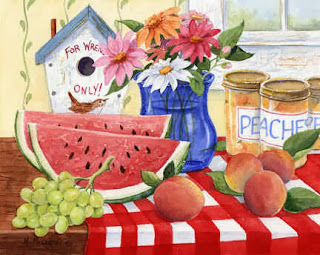domingo, 20 de abril de 2014
martes, 7 de enero de 2014
STILL LIFE ARTWORK
BILINGUAL ART CLASS:
>>>For more examples: (click en la foto)
>>> How to do it Watch this video:
A still life (plural still lifes) is a work of art depicting mostly inanimate subject matter, typically commonplace objects which may be either natural (food, flowers, dead animals, plants, rocks, or shells) or man-made (drinking glasses, books, vases, jewelry, coins, pipes, and so on). With origins in the Middle Ages and Ancient Graeco-Roman art, still-life painting emerged as a distinct genre and professional specialization in Western painting by the late 16th century, and has remained significant since then.
(Wikipedia Enciclopedia libre.)
(Wikipedia Enciclopedia libre.)
Enlaces para saber más:
- Wikipedia:
- Artyfactory:
- Listen to this music while creating your Still life artworks:
lunes, 6 de enero de 2014
PLANTS
There are hundreds of thousands of different plants in the world. How many kinds of plants can you think of? There are trees, bushes, vegetables, flowers, grasses, and many more. Even though there is such a variety of plants, all of them have several things in common.
Plants have roots. Roots are very important parts of plants in many ways. Roots absorb water and nutrients that plants need to grow. They also can store that food. Some plants like radishes, carrots, and turnips store their food in their roots. Roots also help to support plants. Have you seen the huge roots of some trees?
Plants have stems. Some plants use their stems for storage. Desert cacti store water and food in their stems. Stems move water and food from the plant's roots to its leaves and flowers. They also support leaves and flowers. You may think all stems are easy to see, like that of a tree. But some stems stay underground. The potato you eat is an underground stem!
Now watch this video and think of how many different things you would like to know about plants.
Plants have roots. Roots are very important parts of plants in many ways. Roots absorb water and nutrients that plants need to grow. They also can store that food. Some plants like radishes, carrots, and turnips store their food in their roots. Roots also help to support plants. Have you seen the huge roots of some trees?
Plants have stems. Some plants use their stems for storage. Desert cacti store water and food in their stems. Stems move water and food from the plant's roots to its leaves and flowers. They also support leaves and flowers. You may think all stems are easy to see, like that of a tree. But some stems stay underground. The potato you eat is an underground stem!
Now watch this video and think of how many different things you would like to know about plants.
viernes, 3 de enero de 2014
Brahms
Brahms
(1833-1897)
Johannes Brahms fue un excelente pianista y compositor alemán de música clásica del Romanticismo.
Entre sus obras orquestales se encuentran distintas sinfonías y oberturas.
Sin embargo las piezas más populares del compositor han sido las Danzas Húngaras.
Quizás la más conocida es la número 5.
(1833-1897)
Johannes Brahms fue un excelente pianista y compositor alemán de música clásica del Romanticismo.
Entre sus obras orquestales se encuentran distintas sinfonías y oberturas.
Sin embargo las piezas más populares del compositor han sido las Danzas Húngaras.
Quizás la más conocida es la número 5.
Suscribirse a:
Comentarios (Atom)


